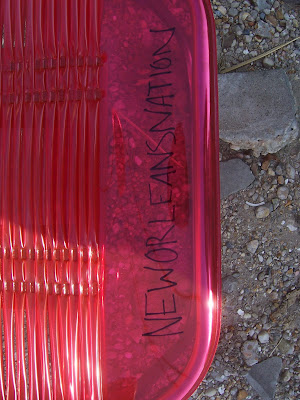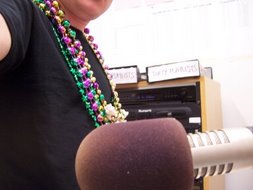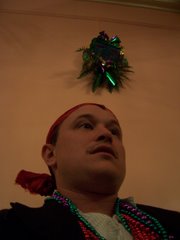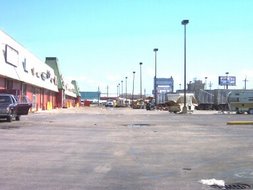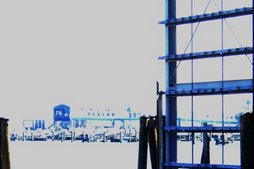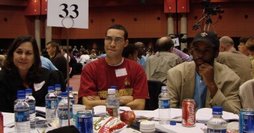
About a week ago, we made a plan for the barrier’s future. Often we stop there on the way to or from our place, taking in the odd landscape spread out around the block. But now we’d hit upon an easy idea to use the space, or rather, to influence its use.
The barrier cuts across Magazine Street, which runs from Canal Street downtown to Broadway uptown. Consisting of three jersey dividers, a barely standing stretch of cyclone fence, and the sunken ground left behind by a water main break 4 or 5 years ago, the barrier is well known. People come upon it when heading uptown—the direction Magazine runs in this section—and ignoring the meager “Road Closed” sign a block earlier at Erato Street. If you sit there for a few hours, you witness many a frustrated u-turn, along with the usual passing oddball from the neighborhood, the silent thinkers of the Abstract Bookstore, and young couples in search of brunch at Surrey’s.
The two collapsing houses on the block sit across from each other, their fallen corners now patched up and covered in construction tarps. On the riverside uptown sits a parking lot belonging to one of several body shops in the neighborhood; on the lakeside, an empty stretch of weeds runs through to Camp Street.
Pedestrians and cyclists usually travel down the middle of Magazine and pass through the space between the dividers. The asphalt is worn away in around the dividers, and a sand and gravel floor surrounds them. Though there appears to be progress in the renovation of several of the houses, the barrier is a long way from disappearing.
So on Saturday, Kim and I stopped in a sporting goods store on the West Bank and picked up 6 vinyl strap lawn chairs, 4 pink and 2 blue. That night, we walked down to the barrier to think things over. On the block before the barrier, there sits a house nearly swallowed by the accumulated detritus of its inhabitants, a man and woman who apparently share a serious packrat complex. Refuse of all sizes and shapes sits in a pile in their small front yard and overflows onto their porch. Among the broken furniture and boards, crates and twists of scrap metal, two junkyard dogs bark at passersby.
This time we didn’t see them, but noticed two kittens crossing the street in light of the streetlamps. As we reached the broken down, junk-laden truck in front of the packrat house, we saw several more kittens sticking their heads up from the pile. A skinny mama cat emitted a low growl and we tried to assure her we meant no harm.
At the barrier, we talked about the best way to position the chairs. A strange plane appeared overhead, low and white with propellers on the wings. It swooped in a circle and disappeared, then passed by again three times. On the underside of the wings, we could read the word “mosquito,” as thin lines of spray fell down on us and on the neighborhood. A man walked by at one point. We exchanged “hellos,” then he moved on. While we were standing on either side of the space between the dividers, a woman on a bicycle flew between us like we were unseen ghosts.

This morning, we took the 6 chairs and a pot of coffee down there and set up camp. We placed three chairs each in semicircles on the uptown and downtown sides of the barrier. On each, we wrote “N.O.N.” on the back and “NEWORLEANSNATION” on the seat. Then we sat down across from each other and had our coffee.

The first person to appear was an older black guy on a bike, who said good morning and kept riding. The next was a white guy on a bike, who also continued after saying good morning.

Then a black guy walked up and stopped to talk to us.
“I went to school up here, back in the 70’s. It sure has changed.” He motioned toward the school across from our apartment. I asked if he was from the neighborhood.

“This the first I been back, since the storm. I live in Texas. Master P is from right over there, you know that?” He then told us that Master P lived a block towards the river, Mystikal was raised up a block from the barrier, and Juvenile lived over in Magnolia. He named several projects—St. Thomas, Iberville, Magnolia, and Melpomene Street, seemed to get a little confused, but confirmed to us twice that we were sitting, “in the middle of the world.”
“This the middle of the world,” he said as he walked up the block away from us.

A few minutes later, a white guy rode past on a bike, his dog trotting on a leash at his side.

We left the chairs and went home, stopping to talk when an older black woman asked us in an African or West Indian accent, “What’s going on today?” Her sister owns a house and one of the body shops, as well as the parking lot, and she stays there for now while her house on N. Broad is being rebuilt. We talked a little while then went on our way when she got a call on her cell.

An hour later, we drove to Armstrong Park to meet up with b.rox and a group of 10 others. Along with Daniel Samuels, Bart led us on a grand journey along the Lafitte Corridor, a blighted green space where once a canal and railroad tracks ran from Basin Street to the end of Canal Boulevard in Mid-City. The Friends of Lafitte Corridor aim to create a real trail way along this 3 mile stretch, and after hiking with them, we understand the potential such a path has for revitalizing a long strip of the city.

Look here for a FOLC account of the trip, and click here for a selection of our photos.
After a few drinks at the Bulldog on Canal and an air-conditioned bus-ride, we retrieved the Windstar on Rampart and drove home. We checked on the chairs, and there they all still sat, three on either side of the barrier. This was around 4:00, and we planned to go back down for a drink at dusk.

An hour later, as Kim napped, I went downstairs to fix the new license plate to the van. When I looked down the block, I could see the chairs were gone. I walked to the barrier and confirmed the disappearance, then returned home, scanning every house and truck for the chairs.
We were a little upset, but that’s the nature of this kind of project—it could get jacked. It’d be nice if everyone saw the potential for a meeting space, or appreciated an aesthetic way to call attention to the barrier’s continued devolvement, to the issues facing the streets before the storm, but realistically, people see free chairs. Who knows who took them? Might’ve been the packrats, the Abstracts, or some idiots making a U-turn who decided to grab 6 shiny objects. The only thing we can take from the theft was that scavenging, rather than buying new, is the smartest way to continue our plan. We’ll pick up chairs people throw out and bring them to the barrier.
We’re eating on the balcony when Kim spots a man riding a bicycle up Magazine, one of our pink chairs in hand.
“Hey!” I yell. “Hey! Where’d you get that chair?! Hey!”
Kim starts yelling in Spanish, as the guy looked to be Hispanic. Two women on the corner think she’s yelling at them, and as she explains to them the loss of the chairs, I race downstairs and jump on my bike, recently equipped with a really fresh gel-seat from the sporting goods store.
I catch up to the dude at Race Street, but the chair was gone.
“Where’s that chair?” I ask, riding next to him and smiling. “You seen that chair?”
He mumbles something, shrugs.
“Where’d you find it?” I ask.
“No, man, no comprendo.” He shakes his head slightly, unperturbed.
“Alright.” I race up the block, thinking I’d caught that guy pretty quick and maybe he wasn’t the one we’d seen. As I cross Felicity, though, I see no other bikers ahead of me, and so circle back around.
The street suddenly comes alive. A man argues with someone inside a pick-up truck next to Dat’s Grocery. Two of the Abstracts ride by on bicycles, looking spooky as ever, the one dressed like he wished he had a Harley. A kid, I think from the African’s block, rides towards me, saying something to the Abstracts, and something to me about police. I continue past Race St., and try to peer in a Dumpster as I ride.
At Euterpe, I see it: one pink chair propped against the tall black fence of the half-gutted mansion on our block. I swing over to the curb and pick it up. Two white men walking a dachshund watch me. I explain to them what happened, then ride on down Magazine, chair in one hand. As I get to our place, I hold the chair aloft in one hand, wave it over my head so Kim can see it from the balcony. We start laughing. Our neighbor, Miss Joan, is on the first floor porch and I tell her of the rescue. She starts to say something about the illegals and I take the bike and chair inside.
So now the pink chair sits on our balcony, where Kim and I finished our meal in a celebratory mood. We’ll continue this barrier project, but right now it’s funny to think that somewhere, someone is selling stolen lawn chairs with “NEWORLEANSNATION” written on them.
